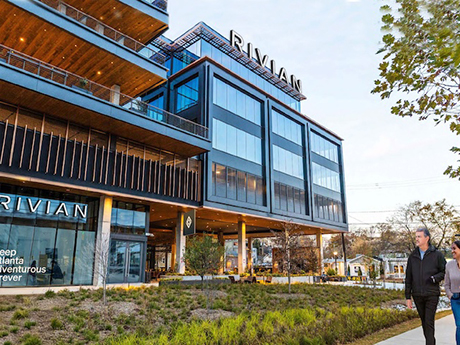Atlanta’s commercial office market is at a pivotal moment, caught between signs of stabilization and the lingering effects of a post-pandemic reset. Vacancy remains elevated, absorption is improving and tenant preferences continue to evolve — but fundamentals are beginning to shift as the market adjusts to the new workplace.
Signs of a bottom?
Hybrid work models, space optimization strategies and cautious expansions have elevated metro Atlanta’s office vacancy rates. Direct vacancy rates surpassed 24 percent for the first time and are hovering near all-time highs.

Meanwhile, sublease availabilities have declined over 25 percent from their peak in 2023, and quality space remains difficult to find. The slowing pace of vacancy increases suggests the market may be nearing a turning point after recording negative annual absorption in four of the past five years.
Net absorption, a key indicator for overall office sector health, totals negative 438,000 square feet, according to Colliers’ second-quarter 2025 report. While still in the red, this marks a significant improvement over previous years. Recent leasing activity suggests even more positive movement in the second half of the year, indicating that tenant departures are tapering and space givebacks are moderating.
Leasing: quality vs. quantity
Despite economic headwinds, leasing activity has shown resilience. The regional labor force remains attractive for corporate campuses and innovation initiatives, evidenced by Mercedes-Benz’s plan to expand its North American headquarters in Sandy Springs, Duracell’s R&D headquarters near Georgia Tech and Rivian’s new East Coast headquarters on the Atlanta BeltLine in Inman Park.
Other major commitments in 2025 include TriNet’s 145,000-square-foot lease at High Street, Boehringer Ingelheim’s 74,000-square-foot lease at The Medley in North Fulton and renewals by AT&T and Quikrete in Buckhead and Central Perimeter, respectively. These deals reflect a broader trend: tenants are prioritizing quality, targeting trophy assets and newly delivered buildings in prime submarkets like Midtown, Buckhead and Central Perimeter.
Longer lease terms and earlier commitments are becoming more common, signaling tenant confidence in stabilized rental rates and a desire to lock in favorable terms before further tightening. However, tenants are also scrutinizing building ownership and demanding higher improvement allowances and concessions — especially in dated properties.
Rents holding steady
Asking rents across Atlanta have remained stable or posted slight gains, with trophy buildings seeing annual increases of roughly 4 percent and marginal growth in the broader market. Prime submarkets continue to see the greatest rent pressure, with rate growth in top-tier buildings far outpacing that of Class B and older inventory.
Concessions such as tenant improvement (TI) dollars and rental abatements remain prevalent, particularly for outdated office properties facing functional obsolescence or deferred capital needs. Owners of these buildings are competing heavily on incentives as they target redevelopment or repositioning, especially in Atlanta’s suburban nodes.
Distress meets opportunity
Investment activity is gradually rebounding, and elevated levels of distress are raising expectations of increased deal flow in the second half of 2025. While first-quarter volume was still 70 percent below pre-pandemic levels, investor interest is rising — especially for well-located, stabilized assets. Recent trades in Midtown and Central Perimeter underscore the appetite for high-quality product.
Distressed assets are drawing attention as potential candidates for mixed-use conversion or alternative uses. Investors are watching closely for clarity on long-term occupancy trends and pricing benchmarks for underperforming buildings.
Differentiation in motion
• Midtown continues to lead in leasing and investment, attracting tech firms, law practices and Fortune 500 headquarters. Its walkability, amenities and talent pool make it a magnet for professional services.
• Buckhead is regaining momentum, particularly among financial services and consulting firms. For the first time since the pandemic, large blocks of premium space (more than 100,000 square feet) are in short supply.
• Central Perimeter and Sandy Springs are benefiting from corporate relocations and expansions, offering competitive rents and strong transportation access. These submarkets are increasingly seen as value plays for companies seeking suburban convenience without sacrificing quality.
Looking ahead
Atlanta’s office sector is showing early signs of recovery. Stabilizing vacancy, steady leasing and modest rent growth in prime assets suggest the market is finding its footing. With a shrinking development pipeline, and improving investor sentiment, further tightening may occur in the latter half of 2025 — particularly in trophy buildings and well-located properties.
Legacy inventory will remain challenged, prompting redevelopment, repositioning and competitive pricing to remain relevant. The market’s trajectory will hinge on the resilience of local employment, the pace of corporate expansion and the evolution of workplace strategies.
As 2025 progresses, expect continued divergence between best-in-class assets and the broader office stock. Atlanta’s office market isn’t just recovering — it’s being reinvented for tomorrow’s workplace.
— By Pete Shelton, Senior Vice President and Principal of Colliers. This article was originally published in the October 2025 issue of Southeast Real Estate Business.


